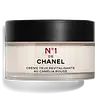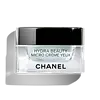What's inside
What's inside
 Key Ingredients
Key Ingredients

 Benefits
Benefits

 Concerns
Concerns

 Ingredients Side-by-side
Ingredients Side-by-side

Camellia Japonica Flower Water
Skin ConditioningWater
Skin ConditioningGlycerin
HumectantButylene Glycol
HumectantSqualane
EmollientSodium Acrylates Copolymer
Propanediol
SolventAlbizia Julibrissin Bark Extract
MaskingCamellia Japonica Seed Oil
EmollientSaccharomyces Cerevisiae Extract
Skin ConditioningFaex
Skin ConditioningCamellia Japonica Flower Extract
EmollientSigesbeckia Orientalis Extract
Skin ConditioningPentylene Glycol
Skin ConditioningEthylhexylglycerin
Skin ConditioningCellulose
AbsorbentLecithin
EmollientPhospholipids
Skin ConditioningSclerotium Gum
Emulsion StabilisingChlorphenesin
AntimicrobialEscin
TonicCaprylyl Glycol
EmollientCyamopsis Tetragonoloba Gum
Emulsion StabilisingMaltodextrin
AbsorbentBeta-Sitosterol
Emulsion StabilisingArginine
MaskingTocopherol
AntioxidantAdenosine
Skin ConditioningSodium Hyaluronate
HumectantLactic Acid
Buffering1,2-Hexanediol
Skin ConditioningTin Oxide
AbrasiveSodium Benzoate
MaskingPalmitoyl Tetrapeptide-7
Skin ConditioningCI 77891
Cosmetic ColorantMica
Cosmetic ColorantCamellia Japonica Flower Water, Water, Glycerin, Butylene Glycol, Squalane, Sodium Acrylates Copolymer, Propanediol, Albizia Julibrissin Bark Extract, Camellia Japonica Seed Oil, Saccharomyces Cerevisiae Extract, Faex, Camellia Japonica Flower Extract, Sigesbeckia Orientalis Extract, Pentylene Glycol, Ethylhexylglycerin, Cellulose, Lecithin, Phospholipids, Sclerotium Gum, Chlorphenesin, Escin, Caprylyl Glycol, Cyamopsis Tetragonoloba Gum, Maltodextrin, Beta-Sitosterol, Arginine, Tocopherol, Adenosine, Sodium Hyaluronate, Lactic Acid, 1,2-Hexanediol, Tin Oxide, Sodium Benzoate, Palmitoyl Tetrapeptide-7, CI 77891, Mica
Water
Skin ConditioningGlycerin
HumectantBetaine
HumectantCoco-Caprylate/Caprate
EmollientCaprylic/Capric Triglyceride
MaskingDiglycerin
HumectantIsononyl Isononanoate
EmollientLimnanthes Alba Seed Oil
Skin Conditioning1,2-Hexanediol
Skin ConditioningCamellia Japonica Flower Water
Skin ConditioningCamellia Japonica Flower Extract
EmollientHydrolyzed Rhodophyceae Extract
Faex
Skin ConditioningZingiber Officinale Root Extract
MaskingCastor Oil/Ipdi Copolymer
Butylene Glycol
HumectantAcrylates/C10-30 Alkyl Acrylate Crosspolymer
Emulsion StabilisingAlumina
AbrasiveChlorphenesin
AntimicrobialCaprylyl Glycol
EmollientTamarindus Indica Seed Gum
Emulsion StabilisingSodium Hyaluronate
HumectantSodium Hydroxide
BufferingDipropylene Glycol
HumectantCamellia Oleifera Seed Oil
Skin ConditioningTrisodium Ethylenediamine Disuccinate
Astragalus Gummifer Gum
Emulsion StabilisingGlucose
HumectantPentylene Glycol
Skin ConditioningTin Oxide
AbrasiveTocopherol
AntioxidantRicinus Communis Seed Oil
MaskingAcetyl Tetrapeptide-5
HumectantHelianthus Annuus Seed Oil
EmollientCI 40800
Cosmetic ColorantCI 42090
Cosmetic ColorantCI 77891
Cosmetic ColorantMica
Cosmetic ColorantWater, Glycerin, Betaine, Coco-Caprylate/Caprate, Caprylic/Capric Triglyceride, Diglycerin, Isononyl Isononanoate, Limnanthes Alba Seed Oil, 1,2-Hexanediol, Camellia Japonica Flower Water, Camellia Japonica Flower Extract, Hydrolyzed Rhodophyceae Extract, Faex, Zingiber Officinale Root Extract, Castor Oil/Ipdi Copolymer, Butylene Glycol, Acrylates/C10-30 Alkyl Acrylate Crosspolymer, Alumina, Chlorphenesin, Caprylyl Glycol, Tamarindus Indica Seed Gum, Sodium Hyaluronate, Sodium Hydroxide, Dipropylene Glycol, Camellia Oleifera Seed Oil, Trisodium Ethylenediamine Disuccinate, Astragalus Gummifer Gum, Glucose, Pentylene Glycol, Tin Oxide, Tocopherol, Ricinus Communis Seed Oil, Acetyl Tetrapeptide-5, Helianthus Annuus Seed Oil, CI 40800, CI 42090, CI 77891, Mica
 Reviews
Reviews

Ingredients Explained
These ingredients are found in both products.
Ingredients higher up in an ingredient list are typically present in a larger amount.
1,2-Hexanediol is a synthetic liquid and another multi-functional powerhouse.
It is a:
- Humectant, drawing moisture into the skin
- Emollient, helping to soften skin
- Solvent, dispersing and stabilizing formulas
- Preservative booster, enhancing the antimicrobial activity of other preservatives
Butylene Glycol (or BG) is used within cosmetic products for a few different reasons:
Overall, Butylene Glycol is a safe and well-rounded ingredient that works well with other ingredients.
Though this ingredient works well with most skin types, some people with sensitive skin may experience a reaction such as allergic rashes, closed comedones, or itchiness.
Learn more about Butylene GlycolCamellia Japonica Flower Extract comes from the Japanese Camellia plant. This plant is native to East Asia and known as "Tsubaki" in Japanese.
Tsubaki flowers possess antioxidant and soothing properties. This flower has shown to be effective at fighting pollution damage by protecting your skin's fibroblasts. Your skin's fibroblasts help create collagen and collagen is responsible for youthful, plump skin.
This flower also contains many antioxidant enzymes. Antioxidants help fight free-radical molecules. Free-radical molecules are capable of damaging our cells and other genetic material. They may originate from sunlight, air pollution, or cigarette smoke. These free-radical molecules are unstable and are often looking for missing electrons. This instability causes free-radicals to damage our cells. Antioxidants help stabilize free-radicals by donating extra electrons.
Thus, Camellia Japonica Flower Extract may help reduce the signs of aging.
Learn more about Camellia Japonica Flower ExtractWe don't have a description for Camellia Japonica Flower Water yet.
Caprylyl Glycol is a humectant and emollient, meaning it attracts and preserves moisture.
It is a common ingredient in many products, especially those designed to hydrate skin. The primary benefits are retaining moisture, skin softening, and promoting a healthy skin barrier.
Though Caprylyl Glycol is an alcohol derived from fatty acids, it is not the kind that can dry out skin.
This ingredient is also used as a preservative to extend the life of products. It has slight antimicrobial properties.
Learn more about Caprylyl GlycolChlorphenesin is a synthetic preservative. It helps protect a product against bacteria in order to extend shelf life. In most cases, Chlorphenesin is paired with other preservatives such as phenoxyethanol and caprylyl glycol.
Chlorphenesin is a biocide. This means it is able to help fight the microorganisms on our skin. It is also able to fight odor-releasing bacteria.
Chlorphenesin is soluble in both water and glycerin.
Studies show Chlorphenesin is easily absorbed by our skin. You should speak with a skincare professional if you have concerns about using Chlorphenesin.
Learn more about ChlorphenesinCi 77891 is a white pigment from Titanium dioxide. It is naturally found in minerals such as rutile and ilmenite.
It's main function is to add a white color to cosmetics. It can also be mixed with other colors to create different shades.
Ci 77891 is commonly found in sunscreens due to its ability to block UV rays.
Learn more about CI 77891We don't have a description for Faex yet.
Glycerin is already naturally found in your skin. It helps moisturize and protect your skin.
A study from 2016 found glycerin to be more effective as a humectant than AHAs and hyaluronic acid.
As a humectant, it helps the skin stay hydrated by pulling moisture to your skin. The low molecular weight of glycerin allows it to pull moisture into the deeper layers of your skin.
Hydrated skin improves your skin barrier; Your skin barrier helps protect against irritants and bacteria.
Glycerin has also been found to have antimicrobial and antiviral properties. Due to these properties, glycerin is often used in wound and burn treatments.
In cosmetics, glycerin is usually derived from plants such as soybean or palm. However, it can also be sourced from animals, such as tallow or animal fat.
This ingredient is organic, colorless, odorless, and non-toxic.
Glycerin is the name for this ingredient in American English. British English uses Glycerol/Glycerine.
Learn more about GlycerinMica is a naturally occurring mineral used to add shimmer and color in cosmetics. It can also help improve the texture of a product or give it an opaque, white/silver color.
Serecite is the name for very fine but ragged grains of mica.
This ingredient is often coated with metal oxides like titanium dioxide. Trace amounts of heavy metals may be found in mica, but these metals are not harmful in our personal products.
Mica has been used since prehistoric times throughout the world. Ancient Egyptian, Indian, Greek, Roman, Aztec, and Chinese civilizations have used mica.
Learn more about MicaPentylene glycol is typically used within a product to thicken it. It also adds a smooth, soft, and moisturizing feel to the product. It is naturally found in plants such as sugar beets.
The hydrophilic trait of Pentylene Glycol makes it a humectant. As a humectant, Pentylene Glycol helps draw moisture from the air to your skin. This can help keep your skin hydrated.
This property also makes Pentylene Glycol a great texture enhancer. It can also help thicken or stabilize a product.
Pentylene Glycol also acts as a mild preservative and helps to keep a product microbe-free.
Some people may experience mild eye and skin irritation from Pentylene Glycol. We always recommend speaking with a professional about using this ingredient in your routine.
Pentylene Glycol has a low molecular weight and is part of the 1,2-glycol family.
Learn more about Pentylene GlycolSodium Hyaluronate is hyaluronic acid's salt form. It is commonly derived from the sodium salt of hyaluronic acid.
Like hyaluronic acid, it is great at holding water and acts as a humectant. This makes it a great skin hydrating ingredient.
Sodium Hyaluronate is naturally occurring in our bodies and is mostly found in eye fluid and joints.
These are some other common types of Hyaluronic Acid:
Learn more about Sodium HyaluronateTin Oxide is an inorganic oxide used to add opacity and volume to a product. In nature, it is already found in mineral form. The main ore of tin is an opaque and shiny mineral called casseterite.
Tin Oxide helps remove translucency in a product, or make it more opaque. Besides adding opacity, tin oxide is used for bulking to add volume.
Tocopherol (also known as Vitamin E) is a common antioxidant used to help protect the skin from free-radicals and strengthen the skin barrier. It's also fat soluble - this means our skin is great at absorbing it.
Vitamin E also helps keep your natural skin lipids healthy. Your lipid skin barrier naturally consists of lipids, ceramides, and fatty acids. Vitamin E offers extra protection for your skin’s lipid barrier, keeping your skin healthy and nourished.
Another benefit is a bit of UV protection. Vitamin E helps reduce the damage caused by UVB rays. (It should not replace your sunscreen). Combining it with Vitamin C can decrease sunburned cells and hyperpigmentation after UV exposure.
You might have noticed Vitamin E + C often paired together. This is because it is great at stabilizing Vitamin C. Using the two together helps increase the effectiveness of both ingredients.
There are often claims that Vitamin E can reduce/prevent scarring, but these claims haven't been confirmed by scientific research.
Learn more about TocopherolWater. It's the most common cosmetic ingredient of all. You'll usually see it at the top of ingredient lists, meaning that it makes up the largest part of the product.
So why is it so popular? Water most often acts as a solvent - this means that it helps dissolve other ingredients into the formulation.
You'll also recognize water as that liquid we all need to stay alive. If you see this, drink a glass of water. Stay hydrated!
Learn more about Water